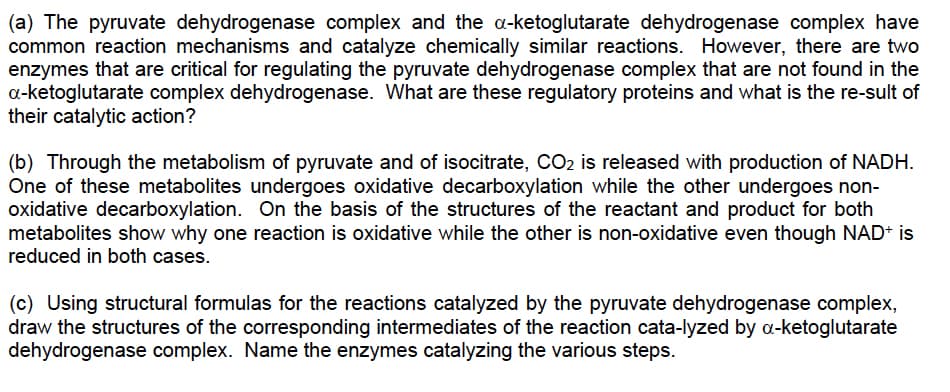(a) The pyruvate dehydrogenase complex and the a-ketoglutarate dehydrogenase complex have common reaction mechanisms and catalyze chemically similar reactions. However, there are two enzymes that are critical for regulating the pyruvate dehydrogenase complex that are not found in the a-ketoglutarate complex dehydrogenase. What are these regulatory proteins and what is the re-sult of their catalytic action? (b) Through the metabolism of pyruvate and of isocitrate, CO₂ is released with production of NADH. One of these metabolites undergoes oxidative decarboxylation while the other undergoes non- oxidative decarboxylation. On the basis of the structures of the reactant and product for both metabolites show why one reaction is oxidative while the other is non-oxidative even though NAD+ is reduced in both cases. (c) Using structural formulas for the reactions catalyzed by the pyruvate dehydrogenase complex, draw the structures of the corresponding intermediates of the reaction cata-lyzed by a-ketoglutarate dehydrogenase complex. Name the enzymes catalyzing the various steps.
(a) The pyruvate dehydrogenase complex and the a-ketoglutarate dehydrogenase complex have common reaction mechanisms and catalyze chemically similar reactions. However, there are two enzymes that are critical for regulating the pyruvate dehydrogenase complex that are not found in the a-ketoglutarate complex dehydrogenase. What are these regulatory proteins and what is the re-sult of their catalytic action? (b) Through the metabolism of pyruvate and of isocitrate, CO₂ is released with production of NADH. One of these metabolites undergoes oxidative decarboxylation while the other undergoes non- oxidative decarboxylation. On the basis of the structures of the reactant and product for both metabolites show why one reaction is oxidative while the other is non-oxidative even though NAD+ is reduced in both cases. (c) Using structural formulas for the reactions catalyzed by the pyruvate dehydrogenase complex, draw the structures of the corresponding intermediates of the reaction cata-lyzed by a-ketoglutarate dehydrogenase complex. Name the enzymes catalyzing the various steps.
Biochemistry
6th Edition
ISBN:9781305577206
Author:Reginald H. Garrett, Charles M. Grisham
Publisher:Reginald H. Garrett, Charles M. Grisham
Chapter25: Nitrogen Acquisition And Amino Acid Metabolism
Section: Chapter Questions
Problem 16P: A Deficiency on 3-Phosphogtycerate Dehydrogenase Can Affect Amino Acid Metabolism Although serine is...
Related questions
Question

Transcribed Image Text:(a) The pyruvate dehydrogenase complex and the a-ketoglutarate dehydrogenase complex have
common reaction mechanisms and catalyze chemically similar reactions. However, there are two
enzymes that are critical for regulating the pyruvate dehydrogenase complex that are not found in the
a-ketoglutarate complex dehydrogenase. What are these regulatory proteins and what is the re-sult of
their catalytic action?
(b) Through the metabolism of pyruvate and of isocitrate, CO2 is released with production of NADH.
One of these metabolites undergoes oxidative decarboxylation while the other undergoes non-
oxidative decarboxylation. On the basis of the structures of the reactant and product for both
metabolites show why one reaction is oxidative while the other is non-oxidative even though NAD+ is
reduced in both cases.
(c) Using structural formulas for the reactions catalyzed by the pyruvate dehydrogenase complex,
draw the structures of the corresponding intermediates of the reaction cata-lyzed by a-ketoglutarate
dehydrogenase complex. Name the enzymes catalyzing the various steps.
Expert Solution
This question has been solved!
Explore an expertly crafted, step-by-step solution for a thorough understanding of key concepts.
This is a popular solution!
Trending now
This is a popular solution!
Step by step
Solved in 4 steps with 1 images

Recommended textbooks for you

Biochemistry
Biochemistry
ISBN:
9781305577206
Author:
Reginald H. Garrett, Charles M. Grisham
Publisher:
Cengage Learning

Biochemistry
Biochemistry
ISBN:
9781305577206
Author:
Reginald H. Garrett, Charles M. Grisham
Publisher:
Cengage Learning